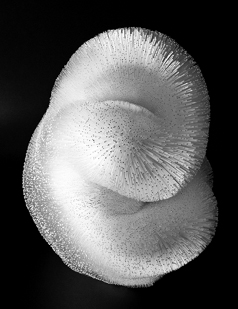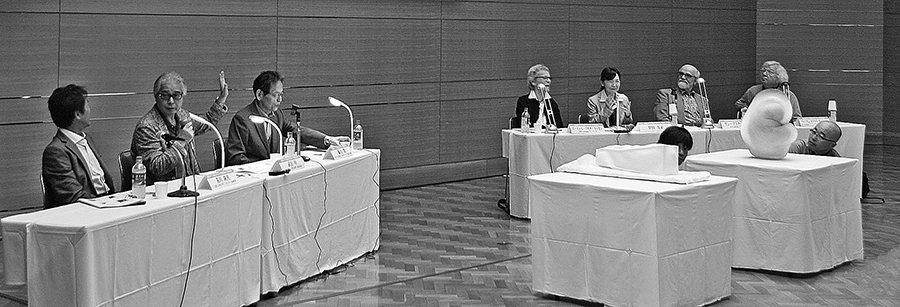Discussion
審査講評(2)
Comment on the Grand Prize Winner

Ambiguity
H49×W38×D38
2016
Takeda ───── First of all, I would like all the jurors to comment on the Final Assessment as well as the Grand Prize winner ‘Ambiguity’ by Ayako Hirogaki. This was the only prize-winning work that received votes from all fives jurors. I would like William Douglas Carlson to be the first to make some comments on the exhibition as a whole and on the Grand Prize winner. Mr Carlson received the Grand Prize at the first World Glass Now exhibition organized by the Hokkaido Contemporary Art Museum in Japan in 1982.
Carlson ───── We agreed and often times in art making, jurors and critics don’t agree. And in agreeing, we found this piece to be stunning not just in a beautiful way but as, in a way, that it’s almost alive. The piece is visually active and visually very kinetic. It looks like it’s moving, almost breathing. And that sense of life is something. It’s rather unique. I think totally unique. Many of this make objects but seldom is a piece. This is captivating. So as we look at the whole exhibition, we see familiar ways of working in glass and again we go back to this piece and remember it because it has a kind of new vocabulary of processes and visual impact.
Takeda ───── Thank you. Next, Ms Laursen.
Laursen ───── Good morning and thank you very much for this opportunity to express my feelings about this competition and about what’s going on also within Danish glass. It is a moving experience within one room to see fantastic works of glass from all over the world. It was from about 40 nation’s artworks coming from all corners of the world. I found it immensely important bringing craft people together and to see what’s moving people to express themselves in the glass medium. As Mr Takeda has told you, all the jurors agreed that this fantastic work should be given the Grand Prize. I think what is so stunning about the piece is that it’s not a piece it’s not an object. It is in a way an impression of the beginning of a new life and it’s also a bit awesome in a way I would say and we were all very happy to find among all the pieces this fantastic work.
Takeda ───── Thank you. Next I would like to ask Yan Zoritchak to comment. Mr Zoritchak received the Grand Prize at the second World Glass Now exhibition. We are fortunate to have the first and the second World Glass Now Grand Prize winners sitting side by side as jurors for this exhibition. Mr Zoritchak, your comments please.
Zoritchak ───── Good morning ladies and gentlemen. I’m pleased to meet you. I have difficulty in speaking English so I prepared my message about the International Exhibition of Glass Kanazawa 2016 as a whole so that Yoshiko may read it. The idea of life is simple. But living one’s life is a hurdle race, a strenuous process, worth to be gone through, spending the appropriate time. The same is the process of creation. To reach the goal, you need patience and time to fulfill your aim. Finally sharing the result with people, with the world around you, brings you strength, tenacity fortitude in your way as a creator. When the idea is good, the shape appropriate, light helps you to magnify the harmony. Thank you so much.
Takeda ───── Thank you. Next, Mr Fujita.
Fujita ───── This is also my first time being part of the Final Assessment Panel. I have been a panel member of the Preliminary Assessment three times at previous exhibitions. Through my experience as a juror at the Preliminary Assessment , I came to realize that the images are quite different from the actual works, and that imagining the size of each work is very difficult. Therefore, I was a little nervous at the Final Assessment. Fortunately, as soon as I entered the room where all the works were gathered, I was immediately impressed by their quality. I have been involved in the activities of the Japan Glass Crafts Association, an organization of glass artists. Comparing the works we saw in that room for the Final Assessment with the works in the catalogue of the first glass exhibition in Japan 40 years ago, there is a great difference in expression and technical improvement between the two. I realized that time has brought great changes in the field of glass art, and that glass art has truly evolved in Japan.
For the final assessment, each juror voted without taking into consideration titles or nationalities. This work by Ayako Hirogaki was selected as the Grand Prize winner. I remember seeing her small works a few years ago, so I was moved, more so than amazed, that the same artist had created such a huge and powerful work with a strong message. Her previous work is cute and small, palm-sized in fact. It is also a charming work and received an award. I feel truly pleased that the same artist has emerged onto a wider stage and exhibited such an extraordinary work at this exhibition. I myself do not fully understand the technique she used to make this work. I hear that she made numerous glass pins and pushed them into the colored urethane rubber in the center. I totally agreed that the Grand Prize goes to this work because I admire her perseverance and the form tugged at my heartstrings.
Takeda ───── Lastly, I myself would like to make some comments. I also voted for the Grand Prize-winning work. Each time, at assessment, I have come across mysterious works. I realized that the artists are pioneers, exploring through expression and technique. This is my second time being confronted with the art of this year’s Grand Prize winner. Previously, I had seen a small work, resembling an alien child, whose strange existence I couldn’t explain. This time, I was astounded when I was faced with such an enormous work. On closer inspection, the artist made numerous glass pins and pushed them into the center. The completed form shows that she had to make hundreds, if not thousands of pins, which must have been an overwhelming task.
She may have created the center part as she searched for a particular shape for her inner and outer self. She has said that her inspiration was ‘the shape of mind and body’. This work resembles a monster peach. Or an alien mother. It looks sensual but at the same time cute. It is mysterious. If it were alive, what kind of existence could it have? I got the impression that we had come across something we had never seen before. It is mystifying. It is often said that there are no limits to expression with glass art. I feel that this work is proof of that.
Next, I would like Jun Fujita to comment on the Gold Prize winner entitled ‘Vestige’. Recently, quite a few works have ambiguous titles like this. I cannot infer anything from it. Jun Fujita, I will leave it to you.


